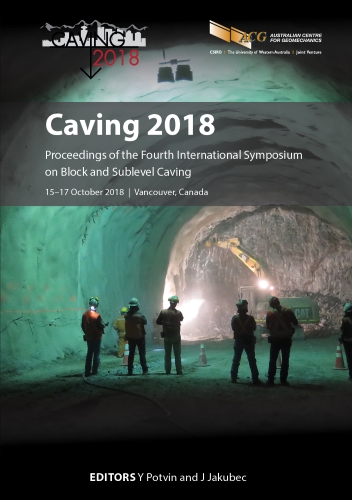Review and simulation of passive seismic tomography in block cave mining

|
Authors: Ghaychi Afrouz, S; Westman, EC |
DOI https://doi.org/10.36487/ACG_rep/1815_14_Afrouz
Cite As:
Ghaychi Afrouz, S & Westman, EC 2018, 'Review and simulation of passive seismic tomography in block cave mining', in Y Potvin & J Jakubec (eds), Caving 2018: Proceedings of the Fourth International Symposium on Block and Sublevel Caving, Australian Centre for Geomechanics, Perth, pp. 223-230, https://doi.org/10.36487/ACG_rep/1815_14_Afrouz
Abstract:
Seismic tomography methods are progressing in crustal seismology and at the smaller mining scale to recognise highly stressed or fracture-prone areas. Velocity variations measured by seismic tomography represent stress concentrations in the rock mass. Changes in these stress conditions are of interest in mining as they are linked to the instability of the underground openings. Rock fracturing generates seismic waves, which propagate with different velocities through portions of the rock mass that have different moduli. Both known and unknown seismic sources in mining environments generate active and passive tomography data, respectively. Active tomography utilises a known source time and location, while passive seismic tomography uses the mining-induced seismic events, for which the source time and location can only be estimated. Mining-induced seismic events generally have relatively low magnitudes, typically lower than ML = 3. The pattern of stress redistribution varies based on different mining methods at different depths. In this study, development of seismic tomography in the mining industry is traced through a review of background theory and recent applications. Additionally, a block caving simulation is presented, including the imaging of cave development, load distribution, and abutment zones. A simple elastic numerical model is used to model stress distribution surrounding a hypothetical block cave. Velocities are assigned to portions of the model corresponding to the stress level. With this velocity model, synthetic travel times are modelled. The synthetic travel times are then used as input to the tomography code. The velocity distribution, which is then generated through the tomography calculations, is compared to the initial, modelled velocity distribution providing a means for validating the quality of the results of the tomography approach for this application.
Keywords: seismic tomography, block caving, stress redistribution, mining-induced seismicity
References:
Bauer, K, Haberland, C, Pratt, R, Hou, F, Medioli, B & Weber, M 2005, ‘Ray-based cross-well tomography for P-wave velocity, anisotropy, and attenuation structure around the JAPEX/JNOC/GSC et al. Mallik 5L-38 gas hydrate production research well’, Geologic Survey of Canada Bulletin, no. 585.
Brzostowski, M & McMechan, G 1991, ‘3-D tomographic imaging of near‐surface seismic velocity and attenuation’, Geophysics, vol. 57, pp. 396–403.
Drnevich, VP & Gray, RE 1981, Acoustic Emissions in Geotechnical Engineering Practice, ASTM Special Technical Publication, vol. 750, ASTM International, West Conshohocken.
Farzampour, A & Kamali-Asl, A 2015, ‘Seismic hazard assessment for two cities in eastern Iran’, Earthquakes and Structures, vol. 8, no. 3, pp. 681–697,
Fehler, M & Rutledge, J 1995, ‘Using seismic tomography to characterize fracture systems induced by hydraulic fracturing’, Proceedings of the 3rd International SEGJ/SEG International Symposium on Geotomography, Society of Exploration Geophysicists, Tulsa.
Han, H, Higgins-Borchardt, SM, Mata, D & Gonzales, VM 2014, ‘In-situ and induced stresses in the development of unconventional resources’, Proceedings of the 2014 SPE/CSUR Unconventional Resources Conference, Society of Petroleum Engineers, Richardson,
Hardy Jr, HR 2003, Acoustic Emission/Microseismic Activity: Volume 1: Principles, Techniques and Geotechnical Applications, A.A. Balkema, Rotterdam.
Herman, GT 2009, Fundamentals of Computerized Tomography: Image Reconstruction from Projection, 2nd edn, Springer, London.
Hoek, E, Kaiser, PK & Bawden, WF 2000, Support of Underground Excavations in Hard Rock, A.A. Balkema, Rotterdam.
Kerr, J 2011, Applications of Double-Difference Tomography for a Deep Hard Rock Mine, MSc thesis, Virginia Polytechnic Institute and State University, Blacksburg.
Ma, X 2014, Passive Seismic Tomography and Seismicity Hazard Analysis in Deep Underground Mines, PhD thesis, Virginia Polytechnic Institute and State University, Blacksburg.
Molka, RJ 2017, Tomographic Imaging Associated with a Mw 2.6 Fault-Slip Event in a Deep Nickel Mine, MSc thesis, Virginia Polytechnic Institute and State University, Blacksburg.
Peterson Jr., JE, Majer, EL, Tura, A & Davey A 1989, Practical Aspects of Crosswell Tomographic Surveys, University of California, Berkeley.
Petr, W, Lubomir, S, Jan, N, Petr, K & Tomas, K 2016, ‘Determination of stress state in rock mass using strain gauge probes CCBO’, Procedia Engineering, vol. 149, pp. 544–552,
Rawlinson, N, Fichtner, A, Sambridge, M & Young, MK 2014, ‘Seismic tomography and the assessment of uncertainty’, Advanced Geophysics, no. 55, pp. 1–76.
Schuster, GT 1998, Basics of Exploration Seismology and Tomography, Stanford Mathematical Geophysics Summer School Lectures, University of Utah, Salt Lake City.
Song, L, Liu, H, Chun, S, Song, Z & Zhang, S 1998, ‘Mapping an underground rock mass by anisotropic acoustical transmission tomography’, Ultrasonics, vol. 36, no. 10, pp. 1009–1012.
Stein, S & Wysession, M 2009, An Introduction to Seismology, Earthquakes, and Earth Structure, Blackwell Publishing, Malden.
Trifu, C-I & Sourineni, FT 2009, Use of Microseismic Monitoring for Rockburst Management at Vale Inco Mines, ESG Solutions, Kingston,
Watanabe, T & Sassa, K 1996, ‘Seismic attenuation tomography and its application to rock mass evaluation’, International Journal of Rock Mechanics and Mining Sciences & Geomechanics Abstracts, vol. 33, no. 5, pp. 467–477.
Westman, EC 2004, ‘Use of tomography for inference of stress redistribution in rock’, IEEE Transactions on Industry Applications, vol. 40, no. 5, pp. 1413–1417.
Westman, EC, Luxbacher, K & Schafrik, S 2012, ‘Passive seismic tomography for three-dimensional time-lapse imaging of mininginduced rock mass changes’, Mining Geophysics, vol. 31, no. 3, pp. 338–345,
Xu, C, Yike, L, Hui, W & Xing, G 2000, ‘Rock mass structure analysis based on seismic velocity and attenuation images’, Chinese Science Bulletin, vol. 45, no. 13, pp. 1211–1216.
Zhang, H & Thurber, HC 2003, ‘Double-difference tomography: the method and its application to the Hayward Fault, California’, Bulletin of the Seismological Society of America, vol. 93, no. 5, pp. 1875–1889.
© Copyright 2025, Australian Centre for Geomechanics (ACG), The University of Western Australia. All rights reserved.
View copyright/legal information
Please direct any queries or error reports to repository-acg@uwa.edu.au
View copyright/legal information
Please direct any queries or error reports to repository-acg@uwa.edu.au
